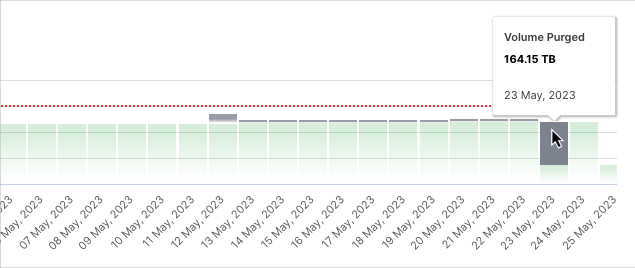- Service Health and Consumption Overview
- Service Health
- License View
- Notifications and Alerts
Long-Term Consumption Details
The Long-Term Consumption Details page displays how much Long-Term Search storage capacity is available, your storage retention period (if any), and a column chart displaying daily data consumption and purge trends.
Timeframe Filter
The timeframe filter applies only to the Long-Term Search column chart. The following timeframes are available:
Prior 7 days – Displays data from the previous seven days. For example, if you were viewing the dashboards on July 8th, you would see data from July 1st through July 7th. Dates are based on UTC time.
Prior 30 days: Displays data from the previous 30 days. For example, if you were viewing the dashboards on March 31st, you would see data from March 1st through March 30th. Dates are based on UTC time.
To change the timeframe, click the filter icon and select a timeframe from the menu.

Long-Term Search Capacity
This consumption bar measures how much data has been consumed and how much storage space is still available.

Long-Term Storage Capacity
This consumption bar displays how much long-term data which is ingested by collectors has been pushed to Long-Term Storage and how much storage space is still available. The data or logs ingested by collectors is moved to the Long-Term Storage Capacity bucket only after the Long-Term Search Capacity bucket is completely utilized.

Retention Period
If you have set a retention period, it is displayed here. The retention period is the length of time that your Long-Term Search data is stored before it is purged. This setting helps you to avoid going over your purchased data limit.
To create or redefine a retention period:
Click the Global Retention Settings link.

The Global Retention Policy page opens.
Click in the Retention Period field to open the drop-down menu.
Do one of the following to select a retention period:
To select a preconfigured timeframe, from the Default tab of the drop-down menu, select one of the available timeframes.
To enter a custom timeframe, select the Custom tab of the drop-down menu, and then enter the Number of Days (must ≥ 31) that you want to retain the data.
Note
Grace Period: Changes that shorten the retention period will be applied after 7 days, while any extensions to the retention period will apply immediately.
During the grace period, logs that fall within the configured retention period will remain visible, but will not be permanently deleted until the grace period concludes.
Click Confirm.
To return to the License View page, click the License View Consumption link.
Long-Term Search
This column chart helps you to identify trends in your Long-Term Search data consumption so you can more effectively manage your purchased data needs. The chart shows the volume of data consumed and purged each day, and compares it to your storage limit.
In the columns, green represents the data consumed, and gray represents the data purged. To view the represented values, move your pointer over the columns and colors within them. The red dotted line shows the amount of purchased data available.

Long-Term Storage
The Long Term Storage chart displays long-term storage log consumption details to enable you to check license consumption based on the volume of ingested data. The chart displays oldest searchable logs and total stored logs to help you classify searchable and non-searchable log data.

Note
To calculate the volume of data ingested by various collectors the previous day for Long Term Storage and Long Term Search, a scheduler is run at 2 AM UTC, hence the Long Term Storage and Long Term Search charts display the details for the previous day after 2AM UTC.